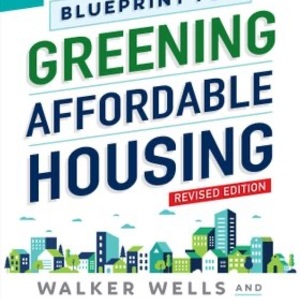
Before a bank puts a foreclosed property back on the market, typically the bank does some bare-bones repairs on the property. What if, instead of doing the bare minimum, the bank decided to look at the foreclosed property as a challenge and opportunity?
While I completely understand the economies of scale in which banks operate — and that most appraisers don’t recognize green improvements as a true value added in the appraisal value of a home — I think this is the most opportune time for banks to re-examine their process. I mean, honestly, it’s not like properties are selling quickly in this market — and what if the properties started selling faster because of the newly, bank-added green elements in the homes? So, if I were a bank and couldn’t do a full green rehab, here is what I would do…
The Quick and Easy
I would focus on the easiest and quickest things to change that would have the greatest impact. I would examine my typical process and then find a green alternative to each of the steps along the way. For example:
Typical Steps in Prep Process
1) New Carpet
2) Paint
3) Professional Cleaning
New Green Process
1) Laminate hardwood floors installed using low-VOC adhesives/sealants. If carpet is a “must have,” use carpet, padding and adhesives that are Carpet and Rug Institute’s Green Label certified. Do not install carpet in basements, bathrooms and laundry rooms — places where moisture problems are more likely to occur. Use resilient flooring.
2) Paint with no-VOC paints, using lead-safe standards.
3) Hire a cleaning crew who uses green cleaning supplies and techniques.
What if the former owner, or a home invader, busted all the toilets and stole all of the appliances? Look at this situation as an opportunity: replace the toilets with low-flow or dual-flush toilets and install Energy Star appliances.
Also instead of putting an unhealthy house back on the market for the next homeowner to have to deal with those issues, implement lead, mold and radon mitigation techniques prior to listing,
Your turn
These are my thoughts… What are some thoughts you have on the subject? What else could banks do to cost effectively green their foreclosure stock?
Weekly Newsletter
Get building science and energy efficiency advice, plus special offers, in your inbox.















13 Comments
Credit Unions vs Banks
Your ideas are great, if you hope/assume finance centers would show some common sense. Locally, at least, the only evidence of common sense seems to come, as usual, from credit unions.
Credit unions like to move things along and might even be encouraged to add features like:
new cfl lightbulbs throughout;
credit toward money down for the new homeowner who 'invests' in green repairs and upgrades.
But, at least in local "mega" banks, common sense is about the last thing we see. They won't even foreclose or short sell most of the time, even if there's a willing buyer, because they have to show a short term loss on their books. Accounting trumps common sense at most every turn, and I'm sure it trumps nature as well.
But if you decide to open a bank, Amy, I'll sign up!
Best wishes, JoeW
Response to Joe W
Thanks for the comments, Joe. I'll let you know if I ever open a bank...you can be customer #1.
Great idea but...
Great idea but some banks won't even replace broken windows, doors, toliets, etc.. But I say go further add insulation, air seal and duct seal along with your upgrades. This would help put some local people to work and then the bank could add it on to the asking price by showing they had helped enerywise or maybe the state or federal gov't could give an incentive to the banks to "go green." I know that might be unpopular because of recent events but if it could be shown to increase jobs and property values it might fly. Banks need to look long term and be community involved. But as we all know it's about the money, who's got it, how do you spend it and where does it come from?
Response to a Great Idea but...by Scott
Great comments, Scott. Wouldn't it be great if we could get banks to understand that this new green initiative with their REO's might help with their public image? What a great marketing campaign for them...going green and creating green jobs!
Existing home energy ratings
Hey Amy -
Maybe the Department of Energy has some help on this issue waiting in the wings. In June of this year, the DOE issued a Request for Information (RFI) on the development of a National Energy Rating Program for Homes (http://apps1.eere.energy.gov/news/progress_alerts.cfm/pa_id=354). The idea is that every existing home would come with "easy-to-understand, reliable information about the energy performance of existing homes, and help them identify cost-effective energy efficiency investments for their homes."
That would get the ball rolling, maybe even within the banking industry.
Lay off the appraisers. The
Lay off the appraisers. The appraiser does not create value. I think talking about appraisers is counter productive. Plus the lending industry has corrupted the appraisal process so much that there are nearly meaningless. Lenders do not value an appraisers opinion, lenders want something on a piece of paper that allows them to make thier commision and go on to the next loan. They dont have the borrowers interest in mind either.
For starters you have to understand an appriaser job, if dne correctly, is to report what the market is doing. It is the appraisers job to estimate what buyers are willing to pay for a home with certain features. This will includes size, quality, style, bedrooms, bathrooms, fireplaces, etc. There do thi buylook at sales data to show what people have paid for such homes.
Now throw in a new feaure that does not have a proven value in the market. It is difficult for an appraiser to estimate what if anything this new feature may have. Please dont point to cost and want to add it to arrive at the value.
With energy efficiecy there are so many variables that it would be nearly impossible to estimate the value of the improvements. Then there is the law of deminishing return. You will gt the biggest bang doing things like air sealing and bring insualtion up to certain levels. As you go farther the return starts demiinishing. How do you place a value on that.. How is a consumer able to place a value on what has been done.
Until the buyers start placing value on energy efficiency dont ask the appraiser to assign a value to it. Lenders could implement policies that affect the loan amount based energy savings. Things like taking in to consideration the cost of utilites in to the lending process.
greening foreclosed properties
Thanks for starting this discussion, Amy. It's one we should be having. I'd like to believe that the solution to our growing stockpile of foreclosed houses involves a partnership between banks and local builders. To start the ball rolling, we'd probably need some grant money for different communities to create a model home from a foreclosed property. Instead of half measures like using CFLs and buying new Energy Star appliances, why not go all the way, performing air-sealing, insulation and HVAC upgrades in addition to the more cosmetic improvements? The end result is a good news story for the community and an educational opportunity on what is possible using the technology and products we have available today. To completely close the loop on this green makeover, the bank would offer a "green" mortgage that takes into account the lower operating costs the house affords. That's my pie-in-the-sky vision.
Green Fix and Flip
I tried one of these over the past year, and the effect of the energy upgrades on the sale price was negligible. The first-time buyer tax credit was at least 5 times more important. Next was the location, (close to light rail, fortunately), hardwood floors, countertop choice (stainless steel), clawfoot tub, curb appeal, etc.
Energy efficiency questions were never asked before closing. All the energy upgrades didn't break the top ten list for my buyer.
I think this is changing fast, however, as buyers are slowly becoming more aware of sustainability.
Colorado does have a green mortgage pilot program based on the HERS score, but it didn't help me or my buyer because I couldn't get it as a non-resident investor, and the buyer couldn't get it because they didn't do the upgrades.
LED Lighting
They did love the LED lighting hack that I did, however:
http://greenbuildingindenver.blogspot.com/2009/12/led-lighting-in-2009.html
More on "Energy Star Mortgages"
Here's the gist of the Energy Star Mortgage program:
"What is the Colorado ENERGY STAR Mortgage Program?
The ESM is a way for the Bank of Colorado and the Governor’s Energy Office to offer better financing for the purchase of newly constructed ENERGY STAR Homes. It can be used in conjunction with any Conventional, FHA or VA loan program to obtain a lower monthly payment.
How do I apply?
Application is simple. Just click here to be taken to the Secure Online Application and enter your information. Your loan qualifications will be evaluated and you will be contacted with a proposal for a mortgage loan for your purchase. You may select the type of loan, term, fees and down payment that is right for you.
What is a discount point?
A discount point is a fee that is charged by a bank when making a mortgage loan. One point equals one percent of the loan amount. In most situations the term is used interchangeably with “origination fee”. The result of the one-time fee is to yield a better interest rate for the life of the mortgage loan. Best of all, when you buy an ENERGY STAR home, this fee is paid for you so you get a better rate with no additional fee."
http://sponcepore-bankofcoloradolo.mortgagewebcenter.com/Default.asp?bhcp=1
Green Products
Here's a couple of resources - I've used Kwal Paint's EnviroKote and loved it http://www.kwalpaint.com/#vocbrochure
A green cleaning company resource in the Dallas/Fort Worth area: http://www.gmaids.com/
Banks...
Banks might be forced into making homes more efficient if the law of the land did not allow selling inefficient homes. Otherwise they might be utilized better by being nicely coerced into financing sustainable retrofits and letting owners, investors and builders who understand the concept of sustainability, design and perform the work. A good example of someone doing this is Dave Robinson of http://www.greenearthequities.com . He's figured out how to buy-fix-sell needy foreclosed homes; help all parties and make a profit without the need for any subsidy. I agree with posters above that the existing banking/real estate systems are getting in the way of sustainability rather than helping it along and that's wasting a wonderful opportunity.
Nyet
Greening a home does add value. "he first-time buyer tax credit was at least 5 times more important. Next was the location, (close to light rail, fortunately), hardwood floors, countertop choice (stainless steel), clawfoot tub, curb appeal, etc.
Energy efficiency questions were never asked before closing. All the energy upgrades didn't break the top ten list for my buyer.
I think this is changing fast, however, as buyers are slowly becoming more aware of sustainability."
^^ The proof is in the $$$. No one I know invests in any green technology unless the payback is less 10years - exterior envelope notwithstanding. So, I like the premise but the execution just isn't going to be meaningful for job creation or profit -->>which means unlikely to happen in meaningful numbers.
I would think tearing down some of the poorly designed and built homes, recycling them and creating smaller, sustainable homes would be more cost effective. Which is, unfortunately, the unavoidable truth.
Log in or create an account to post a comment.
Sign up Log in